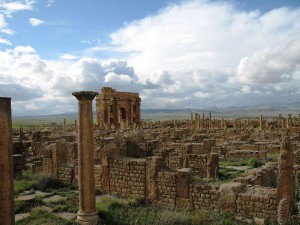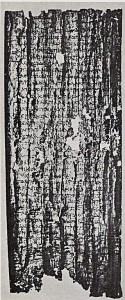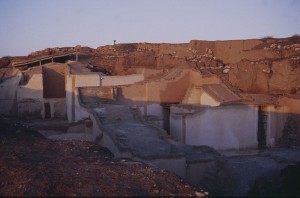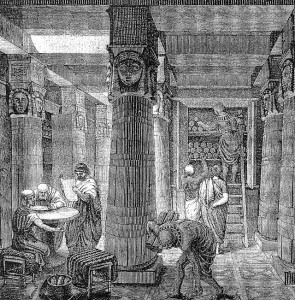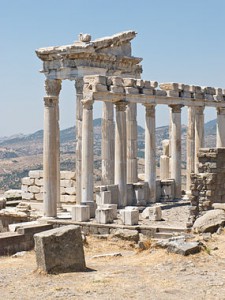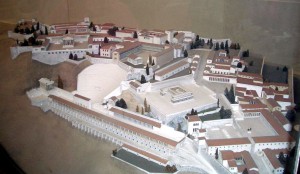5 Amazing Libraries of the Ancient World Posted by Brittany Britanniae on Apr 14, 2015 in Roman culture
In Honor of National Library Week ( in the U.S), I would like to take a moment and honor some of ancient libraries. Some of these libraries are well known and others are rarely discussed. I do hope you like the list! Make sure to comment which libraries should have made the list and why!
1.)Library at Timgad
Where: Timgad (Modern Algeria in the Aures Mountains), Africa
When: 250 A.D
History: The Library at Timgad was a gift to the Roman people by Julius Quintianus Flavius Rogatianus at a cost of 400,000 sesterces (approximately $800,000 U.S dollars) .
Collection Size: While there is no evidence as to the size of the collection the library harbored, it is estimated that it could have accommodated up to 3,000 scrolls.
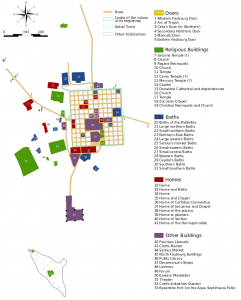
Map of the Archeological site of Timgad. Public Library is Purple #46 in the middle of the city.Courtesy of WikiCommons and Dzlinker
Suggested Dimensions: The library occupied a rectangle eighty-one feet long by seventy-seven feet wide. It consisted of a large semi-circular room flanked by two secondary rectangular rooms, and preceded by a U-shaped colonnaded portico surrounding three sides on an open court.Oblong alcoves held wooden shelves along walls that would likely have been complete with sides, backs, and doors. It is possible that free-standing bookcases in the center of the room, as well as a reading desk, might also have been present.
Distinguishing Features: While the architecture of the Library at Timgad is not especially remarkable, the discovery of the library is historically important as it shows the presence of a fully developed library system in this Roman city, indicating a high standard of learning and culture.
Fate: In the 5th century, the city of Timgad was sacked by the Vandals before falling into decline. It is assumed the library was destroyed at this time.
2.) Villa of the Papyri
Where: Herculaneum, Italy
When: Circa 1st century A.D (obviously before 79 A.D.)
History: This villa’s large private collection may have once belonged to Julius Caesar’s father-in-law, Lucius Calpurnius Piso Caesoninus in the 1st century BC.
Collection Size: Around 1800 carbonized scrolls were found in the villa’s top story. Using modern techniques, previously illegible or invisible sections on scrolls have been unrolled are now being deciphered. It is possible that more scrolls remain to be found in the lower, unexcavated levels of the villa.
Suggested Dimensions: Although, this library was not a large public one. It provides insight into a Roman private or semi-public library. The Villa of Papyri is situated north-west of the town and sits halfway up the slope of the volcano Vesuvius without other buildings to obstruct the view.
Distinguishing Features: The only library known to have survived from classical antiquity- although everything was covered in ash.
Fate: It was buried by the eruption of Mt. Vesuvius that destroyed the town in 79 AD, it was rediscovered in 1752.
3.) Library at Elba
Where: Ebla was one of the earliest kingdoms in Syria. Its remains constitute a tell located about 55 km (34 mi) southwest of Aleppo near the village of Mardikh.
When: 2500 B.C. – 2250 B.C.
History: Elba started as a small settlement in the early Bronze Age (c. 3500 BC), but it developed into a trading empire. Later, it became an expansionist power that imposed its hegemony over much of northern and eastern Syria. However, Ebla was destroyed during the 23rd century BC; it was then rebuilt. Then again, it was destroyed at the end of the third millennium BC, which paved the way for the Amorite tribes to settle in the city and form the third Ebla. The third kingdom flourished again as a trade center; however, it was finally destroyed by the Hittite king Mursili I in c. 1600 BC.
Collection Size: About 1800 complete clay tablets, 4700 fragments and many thousand minor chips were found. The tablets provide many important insights into the cultural, economic, and political life in northern Mesopotamia around the middle of the third millennium BC. They also provide insight into the everyday life of the inhabitants, as well as containing information about state revenues, Sumerian-Eblaite dictionaries, school texts, an archive of provisions and tribute, law cases, diplomatic and trade contacts, Ebla’s hymns, legends, scientific observations, and magic.
Suggested Dimensions: The actual size of the library is uncertain since a majority of the text were found and infrastructure of Palace G was/is still being determined. While this library may have not been a “public library” in the strictest sense, it holds true to be a Palace Archive that may have been open to the public like public records.
Distinguishing Features: The tablets constitute one of the oldest archives and library ever found and there is also tangible evidence of their arrangement and even classification. Furthermore, there was such a sophisticated techniques of arrangement of the texts, coupled with their composition, point to the great antiquity of archival and library practices, which may indeed be far older than was assumed to be the case before their discovery. The Ebla Tablets have thus provided scholars with new insights into the origin of library practices that were in use 4,500 years ago.
Fate: The library is thought to have perished in a fire, but it was in fact a great way to be destroyed! Many of the tablets had not previously been baked, but when all were preserved by the fire that destroyed the palace, their storage method served to fire them almost as thoroughly as if in a kiln.
4.) Library of Alexandria
Where: Alexandria, Egypt
When: It flourished as a major center of scholarship from its construction in the 3rd century B.C until the Roman conquest of Egypt in 30 B.C.
History: The library was created by Ptolemy I Soter, who was a Macedonian general and the successor of Alexander the Great.With collections of works, lecture halls, meeting rooms, and gardens, the library was part of a larger research institution called the Museum of Alexandria, where many of the most famous thinkers of the ancient world studied.
Collection Size: At its height, the library was said to possess nearly half a million scrolls, and, although historians debate the precise number, the highest estimates claim 400,000 scrolls while the most conservative estimates are as low as 40,000, which is still an enormous collection that required vast storage space. This library, with the largest holdings of the age, acquired its collection by laborious copying of originals.
Suggested Dimensions: The exact layout is not known. Classical sources describe the Library of Alexandria as comprising a collection of scrolls, a peripatos walk, a room for shared dining, a reading room, meeting rooms, gardens, and lecture halls. It sounds amazing!The library also is known to have had an acquisitions department and a cataloguing department.
Distinguishing Features: It was one of the largest and most significant libraries of the ancient world. It was dedicated to the Muses, who were the nine goddesses of the arts ( epic poetry, history, song, lyric poetry, tragedy, hymns, dance, comedy and astronomy). Fun fact: Mark Antony supposedly gave Cleopatra over 200,000 scrolls for the library as a wedding gift, taken from the great Library of Pergamum.
Fate: The library is famous for having been burned, resulting in the loss of many scrolls and books, and has become a symbol of the destruction of cultural knowledge. A few sources differ on who is responsible for the destruction and when it occurred. Although there is a mythology of the burning of the Library at Alexandria, the library may have suffered several fires or acts of destruction over many years. One of these fires is even credited to Julius Caesar.
5.) Library of Pergamum or Pergamon
Where: Pergamum, Turkey (Modern Bergama, Turkey)
When: Built 197 B.C- 159 B.C
History: The Attalid kings formed the second best Hellenistic library after Alexandria, founded in emulation of the Ptolemies.
Collection Size: According to Plutarch, Pergamum’s library was said to have housed approximately 200,000 volumes. No index or catalog of the holdings at Pergamum exists today, making it impossible to know the true size or scope of this collection.
Suggested Dimensions: The library was situated on the upper acropolis within Pergamum. Ancient accounts claim that the library possessed a large main reading room, lined with many shelves. Manuscripts were written on parchment, rolled, and then stored on these shelves. An empty space was left between the outer walls and the shelves to allow for air circulation. This was was done in order to prevent the library from becoming overly humid in the warm climate of Anatolia. A statue of Athena, the goddess of wisdom, stood in the main reading room.
Distinguishing Features: Pergamum is credited with being the home and namesake of parchment (charta pergamena). The introduction of parchment also greatly expanded the holdings of the Library of Pergamum.
Fate: Pergamum’s ties to Christianity and the Bible may be one reason for its demise (religious and political reasons not divine). Pergamum is mentioned in the Book of Revelation as the dewelling place of Satan and his throne. The city was damaged badly due to an earthquake in 262 A.D, and sacked by the Goths shortly afterwards. Furthermore, it was invaded by the Persians in the 7th century, but later rebuilt on a smaller scale by Emperor Constans II. Lastly, Pergamon was sacked by the armies of Maslama ibn Abd al-Malik on their way to the siege of Constantinople in 717 A.D

Build vocabulary, practice pronunciation, and more with Transparent Language Online. Available anytime, anywhere, on any device.
About the Author: Brittany Britanniae
Hello There! Please feel free to ask me anything about Latin Grammar, Syntax, or the Ancient World.



